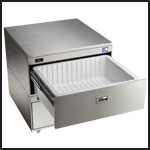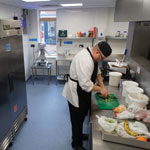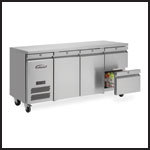Refrigeration – make the right choice
Advances in refrigeration have led to a wider choice of storage units that are increasingly energy efficient, enabling operators to tailor the equipment to meet their specific needs. Diane Lane reports
The increasingly diverse range of refrigerated storage units on the market means that operators can tailor the equipment to suit their own requirements much more than was previously possible.
"There is a wider choice of units on the market than ever and operators need to determine the configuration that will best facilitate the smooth and efficient running of their operation," says Glenn Roberts, managing director of Gram UK.
"The amount of refrigerated storage you need will depend on how often your fresh produce is delivered. If deliveries are daily, this will require less fridge space than deliveries once or twice a week. Upright cabinets are ideal for general storage, while refrigerated counters provide precious worktop space for prep areas and localised refrigeration close to the cook line to minimise staff movement."
The first questions to ask, according to Malcolm Harling, sales and marketing director of Williams Refrigeration, are: What do you want to store? How much storage room do you need? And what space is available?
"All this will impact on what type of refrigeration you want," he says. "Coldrooms offer larger refrigerated storage and are more flexible in terms of their layout than reach-in cabinets. They also offer a good option if accessibility is an issue. Low ceilings or stairs that need negotiating will limit the choice of equipment and a modular coldroom, as opposed to a standard cabinet, may work better as it can be assembled in situ."
Stuart Flint, business and training development manager at Electrolux Professional, says much will inevitably depend on the storage capacity needed.
"Coldrooms might be a necessity for the busiest of kitchens but equipment manufacturers are constantly innovating to increase the usable space available within upright cabinets and you might be surprised how much the latest models can store. Improved air circulation systems, for example, mean there is no need to leave so much space for airflow at the back, sides and top of the cabinet - making room for even more products in the fridge."
upright cabinets
Robin McKnight, managing director of the Catering Equipment Distributors' Association (CEDA), says: "Almost every kitchen will have upright cabinets and they will normally hold the produce required for one day's service if decanted from a coldroom, or two to three days if this is the only source of refrigeration. The average size of a single door cabinet is 600 litres, although smaller kitchens may have units of about 350 litres. There are also single-door units on the market that are capable of supporting 2.1 GN systems which makes the storage of prepped food much simpler."
The equipment footprint has become a key issue in recent years. "Kitchens are getting smaller as operators look to save room back of house so they can have more tables and chairs out front," says Harling. "Manufacturers are being challenged to produce refrigeration with similar capacity in a smaller footprint, as well as new products such as cabinets that can be put on the wall."
The market is constantly innovating to meet the demands of the commercial kitchen, both operationally and environmentally.
The Ecostore range from Electrolux is designed to prolong the life of food with Optiflow, an "intelligent" air circulation system which adapts to the load and ensures temperature uniformity and improved food preservation in any loading condition. Flint explains how it works. "Optiflow ensures the air is circulated around the fridge cavity in horizontal and vertical directions, providing optimum cooling and uniform temperature so items at the top of the fridge are stored at the same temperature as items at the bottom."
Temperature stability
Adande's approach to temperature stability, through its patented insulated drawers which prevent cold air from escaping when opened, was recently put to the test by Griffith Laboratories. John Feeney, culinary director Europe at Griffith, conducted a product quality comparison between items stored in Adande drawers and those stored in conventional refrigeration for seven days.
In his report, Feeney concluded that "the difference in the quality of the food from the Adande drawers and the conventional units was very significant" and that the results "are demonstrative of real difference in performance of the units on maintaining food quality".
Data logging systems are available to assist with HACCP (Hazard Analysis and Critical Control Points) compliance. For example, on its blast chillers and freezers, Williams offers a thermal printer that records all the blast chill and storage cycle data and stores the information for up to seven days, so data is safe even if the paper runs out.
True Refrigeration has designed reversing fan motors for its TGU series of under-counter refrigeration and freezer units to combat what marketing director of True UK, John Lilly, says is a common problem. He explains: "Dirt build-up on the condenser, without regular maintenance, can lead to inefficient operation and eventual compressor failure. These new condenser fan motors reverse during normal operation, helping to keep the condenser coil free from dirt, dust and debris."
The EcoPro G2 range from Foster Refrigerator incorporates more than 50 new innovations including features such as CFD-modelling capability, otherwise known as "Fluid Food-Fresh Technology", a high-visibility temperature display PVAM (power display) which allows for easy temperature monitoring at all times, and the use of cyclopentane foam which provides for a 15% energy saving. Chris Playford, market and development director, says: "Refrigeration operates 24 hours a day, so it has to be a major consideration where energy consumption is concerned."
Energy efficiency
With regard to energy efficiency, Valera has launched its new B-Line range of eco-friendly stainless-steel refrigeration and energy-saving upright chillers. Kurran Gadhvi, marketing manager for Valera, says: "The energy efficiency of refrigerators has improved dramatically over the past few years and many of the newer models now feature sophisticated temperature monitoring systems to ensure optimum performance.
"The search for more environmentally friendly refrigerants has led to a greater use of hydrocarbon gas, which is proven to reduce energy consumption and offers a quicker pull-down time than traditional refrigerants. Besides greener coolants and increased efficiency, many modern fridges now feature recyclable components and thicker insulation."
Gram started to substitute HFCs for natural hydrocarbon refrigerants R290 propane and R600a isobutane in 2002 and, since then, has been manufacturing HFC-free refrigeration across a number of its ranges. "The regulation of refrigerants has changed dramatically over the past 10 years, following on from continued research into the damage they cause to the ozone layer and their contribution to global warming," says Roberts. "Refrigerants continue to come under increasing scrutiny by regulating bodies, with the European Commission preparing to introduce important new controls on some of the most commonly used refrigerants in the not so distant future."
air distribution
With temperature control being integral to the efficient and safe running of refrigeration units, Gram also equips its units with its unique air distribution system to ensure a correct and uniform temperature is maintained throughout the cabinet while drawing on as little energy as possible.
The R600a refrigerant is also incorporated in most of the models in the new Platinum range from Lec, aimed at offering a wider choice of energy-efficient, environmentally friendly refrigeration with a large storage capacity. To maximise the large internal capacity of the units, movable shelving with a wide choice of shelf heights feature across the full range.
The fridges maintain working temperatures of +0°C to +10°C and freezers maintain -18°C to -25°C. An external temperature display prevents the door from being opened solely to conduct temperature checks and a temperature alarm alerts the user if the temperature goes beyond the set range or if the door is accidentally left open.
Simon Frost, regional sales director at Manitowoc, says the new, environmentally friendly gasses such as propane enables units to consume about 25% less electricity compared with units using traditional refrigerants. He adds: "This reduces the running costs and produces less CO2. The Global Warming Potential (GWP) is also greatly reduced, from a rating of 1,300 for R134a to just three with R290a. The other development in this area is with regards to glycol, a food safe anti-freeze that acts as a coolant on a flow and return system. This gives a quicker pull-down speed, a longer holding time and produces no heat emissions or compressor noise."
Manitowoc's Delfield range of refrigeration equipment is designed to operate in higher ambient temperatures, with extra thick CFC-free insulation as standard and cooled naturally with the R290a natural refrigerant.
Playford asserts the right choice of refrigerators, and their position within the kitchen, is crucial in managing energy consumption and costs. He adds: "Making the right choices in this respect can save huge costs in the long term."
Case study: Problems solved
He explains: "Operationally the main problem was constantly bending to get the products needed during service and not being able to find items in the fridge."
He now has four Adande drawers at Café Spice Namasté and two at Mr Todiwala's Kitchen at the London Heathrow Hilton, Terminal 5.
"Using the drawers means we can now see everything in one place for a busy service," he says. "Before, we had a small under-counter freezer for ice-cream; this put out a lot of heat and made the shelf above very hot and unusable. Now with the Adande underneath, I can use the shelf during service for my desserts. Also, we can tell the compressors are not working as hard.
"Temperature stability is the key to everything in a hot kitchen like mine and I have seen a great improvement in the quality of the ice-cream that we are producing. Right in the cook line is where we have seen the greatest improvement in service and the quality of the product that is being stored in the drawers."
Case study: Kitchen space issues
Daniel Ridd, project manager with Peachman, installers of the kitchen, says: "True's wide range of model sizes gave us maximum flexibility in terms of capacity."
The models selected were two upright fridges, two upright freezers and two three-door TGU counters.
As well as cooking for pupils and staff at Little Plumstead, the kitchen prepares dinners for another local primary school, just down the road. "On a typical day we'll do 170 meals," says chef manager Paul Williams.
It's relatively unusual for a primary school kitchen to have under-counter refrigeration cabinets but Ridd explains: "A key feature of this project was the limited space which meant we had to go with cabinets rather than a coldroom.
"The uprights gave us a huge capacity for a relatively small footprint, while the counters enabled us to combine prep surfaces with a large refrigerated capacity, helping create extra storage."
Case study: Environmental performance award
The 10-storey building houses 6,000 people and has two restaurants, a coffee shop and two finishing kitchens. More than 45 items from Williams Refrigeration were installed - including coldrooms, blast chillers, under-counter fridges and freezers and several multi-deck refrigerated food and drink display units - creating an integrated refrigeration system designed to maximise energy savings and minimise heat emissions.
"We had to reduce power and water consumption wherever possible and include materials that would not have a detrimental effect on the rating," says Graham Moore, director of Peter Burholt Partnership, which developed the catering strategy and design for the building.
"Glycol refrigeration was specified for the Level 3 coldrooms and servery refrigeration in order to reduce the quantity of CFCs. This also kept rejected heat outside the building, thereby reducing the air conditioning requirements."
Moore says: "Glycol was a major requirement within our scheme, so we needed a company capable of designing and installing a system where the compressors could be located at roof level, seven floors above the kitchen and servery."
Legislation Update: The Ecodesign Directive
The Catering Equipment Suppliers Association (CESA) answers key questions on the legislation.
What's the point of the Ecodesign Directive?
Its purpose is to improve the environmental performance of energy-related products through "ecodesign". Currently, EU countries have their own disparate legislations covering energy efficiency. Creating a European-wide regulative framework should stop the national legislations from becoming obstacles to intra-EU trade.
How will it affect food service operators?
One of the key areas being considered is energy labelling. It would mean that catering equipment would carry labelling similar to that on domestic equipment, rating it A to G (with A being the most energy efficient). The directive is also designed to encourage the development of energy-saving technologies. Ultimately these would reduce running costs and consumption of resources.
What's the problem with refrigeration?
The main issue is that this will lead to the requirement for products to be tested. The cost of this testing, and any product developments needed to meet the requirements of the directive, will need to be borne by the manufacturer. However, in response to increasing demand for refrigeration that can be tailored to a particular site, manufacturers are making many different model variants and every single variant would need to be tested, adding enormously to cost.
What's the solution?
EFCEM (the European Federation of Catering Equipment Manufacturers, which CESA currently chairs) is working with the EU Commission to come up with a solution that makes economic sense and is environmentally sound. It has suggested that certain refrigeration products are excluded from the directive.
contacts
Adande Refrigeration
01502 537135
www.adande.com
CEDA
01386 793911
www.ceda.co.uk
CESA
020 7793 3030
www.cesa.org.uk
Electrolux Professional
0844 375 3444
www.electrolux-professional.co.uk
Foster Refrigerator
0843 216 8800
www.fosterrefrigerator.co.uk
Gram
01322 616900
www.gram-commercial.com
Lec
0844 248 4274
www.lec-commercial.co.uk
Manitowoc
01483 464900
www.manitowocfsuk.com
True Refrigeration
01709 888888
www.truemfg.com/uk
Valera
0845 270 4321
www.valera.co.uk
Williams Refrigeration
www.williams-refrigeration.com













